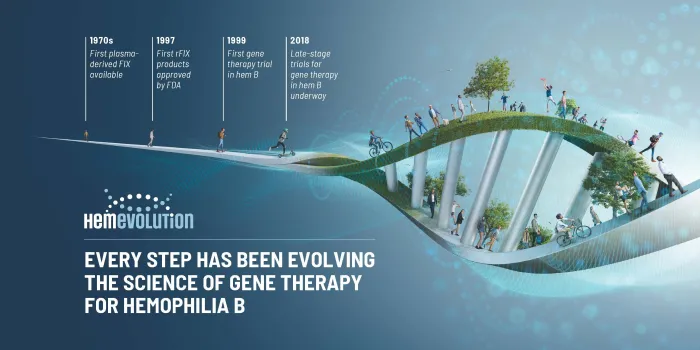Current hemophilia B treatments offer strong protection from bleeds, but impact patient lifestyle and require consistent infusions to keep protection levels high.1
Gene therapy is an innovative approach to treating a medical condition by introducing a new fully functioning, or working, gene into the body, or by turning off or changing the gene that is causing the condition.1,2
Why hemophilia B?
Hemophilia B is a rare bleeding disorder caused by a single genetic mutation—a faulty F9 gene—resulting in the absence or deficiency of factor IX (FIX), a protein primarily produced by the liver that helps blood clots form properly.3 Since it is caused by a single gene mutation, hemophilia B is an appropriate target for treatment with gene therapy.1
While gene therapies being studied for hemophilia are focused on the two most common forms of the condition, hemophilia B is a promising candidate since the F9 gene is much smaller, and less structurally complex, than genes that cause other bleeding disorders.4,5
Approaches for inherited conditions stemming from a single genetic mutation, including hemophilia B, have predominantly focused on the delivery of a working gene using a viral vector.1,6,7 Most gene therapies for hemophilia B currently being studied use a certain type of vector called an adeno-associated virus, or AAV.4 AAV vectors don’t change the patient’s DNA, they just help deliver the working gene to a targeted part of the body.4,7
How gene therapy for hemophilia B works
In gene therapy for hemophilia B, the working copy of the F9 gene is designed with instructions to create the correct protein: factor IX (FIX). The working F9 gene is placed in an AAV vector and delivered to the liver.4,8 Once delivered, the working F9 gene enables the liver to start generating its own FIX, with the goal of allowing a person to produce their own stable and protective levels of FIX.8
The goals of gene therapy for hemophilia B currently being investigated are to provide the long-term benefit of sustained FIX activity levels from a single administration of treatment, and to reduce or even eliminate bleeding and the need for regular, long-term prophylaxis.1
Gene therapy for hemophilia B is built on decades of clinical research, with more than 250 AAV-based clinical trials currently underway across a variety of conditions. So not only is gene therapy a good fit for hemophilia B, it's based on decades of trusted scientific advances.7,9-13
CSL Behring has been focused on advances in hemophilia treatment, and serving that community, for decades. It’s all part of delivering on our promise to transform the lives of people around the world living with serious and rare diseases.
What's potentially the next step in the evolution of hemophilia B treatment? Visit HemEvolution.com to learn more!
- Miesbach W, O’Mahony B, Key NS, Makris M. How to discuss gene therapy for haemophilia? A patient and physician perspective. Haemophilia. 2019;25(4):545-557.
- What is Gene Therapy? US Food and Drug Administration website. https://www.fda.gov/vaccines-blood-biologics/cellular-gene-therapy-prod…. Accessed November 23, 2021
- F9 Gene. MedlinePlus Genetics website. https://medlineplus.gov/genetics/gene/f9/. Accessed July 5, 2022.
- Perrin GQ, Herzog RW, Markusic DM. Update on clinical gene therapy for hemophilia. Blood. 2019;133(5):407-414.
- Bowen DJ. Haemophilia A and haemophilia B: molecular insights [published correction appears in Mol Pathol 2002 Jun;55(3):208]. Mol Pathol. 2002;55(2):127-144.
- Prakash V, Moore M, Yáñez-Muñoz RJ. Current Progress in Therapeutic Gene Editing for Monogenic Diseases. Mol Ther. 2016;24(3):465-474.
- Bulcha JT, Wang Y, Ma H, Tai PWL, Gao G. Viral vector platforms within the gene therapy landscape. Sig Transduct Target Ther. 2021;6:53.
- Dhungel BP, Bailey CG, Rasko JEJ. Journey to the center of the cell: tracing the path of AAV transduction. Trads Mol Med. 2021;27(2):172-184.
- Luxturna. Prescribing Information. Spark Therapeutics; 2017.
- Zolgensma. Prescribing Information. Novartis Gene Therapies, Inc; 2021.
- Grimm D, Zolotukhin S. E Pluribus Unum: 50 Years of Research, Millions of Viruses, and One Goal--Tailored Acceleration of AAV Evolution. Mol Ther. 2015;23(12):1819-1831.
- List of Adeno-Associated Virus Clinical Trials in the European Union as of November 23, 2021. European Union Clinical Trials Register website. https://www.clinicaltrialsregister.eu/ctr-search/search?query=Adeno-ass…. Accessed November 23, 2021.
- List of Adeno-Associated Virus Clinical Trials in the United States as of November 23, 2021. Clinicaltrials.gov. https://clinicaltrials.gov/ct2/results?cond=&term=&type=&rslt=&age_v=&gndr=&intr=AAV&titles=&outc=&spons=&lead=&id=&cntry=&state=&city=&dist=&locn=&rsub=&strd_s=&strd_e=&prcd_s=&prcd_e=&sfpd_s=&sfpd_e=&rfpd_s=&rfpd_e=&lupd_s=&lupd_e=&sort=. Accessed November 23, 2021.

